
How long does a charge of the battery in your phone, tablet or laptop last? How long is it supposed to last? If the tech specs do include battery life, can you trust that number? How was it measured? Can you rely on it? How much does battery life matter? Or is it just something that should last long enough?
When Steve Jobs introduced the Apple iPad in 2010, he said that such a tablet should run ten hours on a job, and that sort of became what people expect from a tablet. With mobile computers used on the job, the industry more or less agreed that a device should last a full shift, generally eight hours. But, again, how is that measured? Are there any standards?
Why isn't there a "Miles-per-Gallon" for mobile computers?
Battery life of a device is generally treated like an afterthought in its specifications. It's usually listed as "approximately" so and so long, or "up to" so many hours. A tiny asterisk may refer to additional information in the fine print at the bottom of the specs. That just doesn't seem like enough.
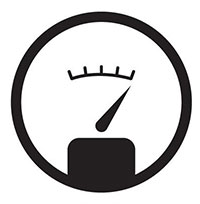 Since battery life definitely matters, why can't it be tested and listed more like gas mileage on a car or truck, so you know how many miles per gallon you can expect (or liters per 100 km in other parts of the world)? Those measures, mandated by the government, may not be perfect, but they do provide an idea of how efficient a vehicle is, and how often you have to fill up. If you know how much fuel goes into your tank and how many miles per gallon your vehicle gets, that gives you a pretty good idea how far you can go and whether that's good enough for your driving habits and patterns.
Since battery life definitely matters, why can't it be tested and listed more like gas mileage on a car or truck, so you know how many miles per gallon you can expect (or liters per 100 km in other parts of the world)? Those measures, mandated by the government, may not be perfect, but they do provide an idea of how efficient a vehicle is, and how often you have to fill up. If you know how much fuel goes into your tank and how many miles per gallon your vehicle gets, that gives you a pretty good idea how far you can go and whether that's good enough for your driving habits and patterns.
That applies to gasoline-powered vehicles. With electric cars, it's a bit more difficult. There you have to go by how many miles the manufacturer or the government says you're going to get from a full charge. You may know what the capacity of your battery is or how much charge you have left, but there isn't a universally accepted measure of efficiency, like the miles per gallon. Plus, you have the extra issues of how fast a charger charges the car, and there really isn't an equivalent to the city, highway, and mixed mileage numbers you get for a gas-powered vehicle. And the maximum capacity of a battery tends to diminish over time. Car magazines have started efforts to include miles per gallon equivalents for electric cars that shows a vehicle's efficiency, like miles per kilo-watt-hour, but it's a work in progress.
Computing electric "mileage"
How does all of the above apply to mobile computers? They have a battery, or batteries, with so and so many watt-hours capacity. What does that mean? Well, watt-hours is a unit of electrical energy stored in a battery. Watt is computed as amps x volts. Amps is the rate at which current flows through a circuit. Volts is sort of like the water pressure in a hose.
An LED bulb may draw four watts, so to have that bulb run for one hour takes four watt-hours. If that LED bulb were in a flashlight powered by three AA batteries, how long would the flashlight work on a set? 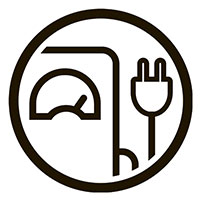 A Double-A battery may be listed as 1.5 Volts and 2800 mAH. Watt = Volt x Amps, so that'd be 1.5V x 2.8Amps = 4.2 watt-hours, or 12.6 watt-hours for all three batteries. So that flashlight would burn for about three hours until the batteries are spent.
A Double-A battery may be listed as 1.5 Volts and 2800 mAH. Watt = Volt x Amps, so that'd be 1.5V x 2.8Amps = 4.2 watt-hours, or 12.6 watt-hours for all three batteries. So that flashlight would burn for about three hours until the batteries are spent.
How can we use those physical facts to figure out how long a charge in a mobile computer lasts? Well, there are a number of ways. We can let the computer run and use an app that measures how many watts it uses to run. Say, the computer draws six watts and the battery is rated 60 watt-hours, divide 60 watt-hours by 6 watts = 10 hours. So that system would run 10 hours on a charge. And we can conclude that the system uses about six watt-hours for each hour of operation.
But, just like it is with gas-powered vehicles where gas mileage varies depending on the type of driving. A vehicle may be EPA-rated at 30 miles per highway gallon, but it's less in city driving, and if you pulled a trailer up a mountain, it might be closer to 10 miles per gallon. It's the same with electricity-powered computers. If the laptop or tablet just idles, it'll use much less energy than when it's loaded down with complex tasks. There is just way around that.
The way it's currently done
But could there not be a standardized way of measuring electrical "mileage"? With gas-powered vehicles, the EPA clearly describes the type of driving used to determine city and highway MPG testing. The same could be done for computers. 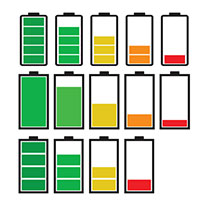 There could be a carefully designed set of tasks that the system would run, and the test would then measure how much energy is consumed to complete the test. The results would then give users an idea of how much battery "life" they can expect.
There could be a carefully designed set of tasks that the system would run, and the test would then measure how much energy is consumed to complete the test. The results would then give users an idea of how much battery "life" they can expect.
That is actually sort of how the computer industry does it today. Except that there really are no standards. One company may use one piece of benchmarking software and the next one another. And stating how many hours the battery will last really only goes for whatever battery is in the system. Since computers' batteries often come with different storage capacities, the "battery life" number is only valid for the battery with which the test was done. And whether or not the result is meaningful depends entirely on how much load the testing utility puts on the system.
The result is that the battery life you'll find in mobile computer specs is not as helpful as it should be. Which is unfortunate, because battery life on a charge matters. Isn't there a better way? In cars, mileage will vary, but at least all manufacturers must use the exact same EPA tests, so the results are somewhat comparable and meaningful. That is not currently the case with battery-powered computers.
Is there a better way?
But what if there were a way? Everyone could, for example, agree to use the exact same testing software that puts a carefully designed mixed load on the system during the testing. It would also fix other parameters, like, for example, how bright the display must be during the testing. 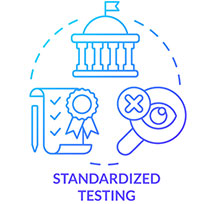 A very bright backlight draws a lot of power, so brightness should be set to a reasonable level, say 200 nits -- perfect for indoor use -- for testing.
A very bright backlight draws a lot of power, so brightness should be set to a reasonable level, say 200 nits -- perfect for indoor use -- for testing.
Then the testing would be conducted, and the utility would measure, knowing the rated Watt-Hour capacity of the battery used, how long it would take to draw battery charge from, say 90% down to 10%. Once the test is done, you know, how many watt-hours the system draws per hour.
Like miles per gallon on your vehicle, you'd know watt-hours per hour on your computer. If the laptop draws 10 watt-hours per hour and the battery has 80 watt-hours capacity, then a full charge of the battery will get you eight hours of continuing operation. You could then also easily calculate how long a smaller or a bigger battery would last. And you would know how power-efficient one computer is compared to another.
Wouldn't that be a very good thing?
What we've been doing
And that's what we've now started doing at RuggedPCReview.com. We use UL Solutions' PCMark 10 Battery test in "Modern Office" mode that continuously runs typical work activities such as writing, web browsing, video conferencing, and similar. This allows us to report the following information in our review and testing results:
- "Battery life" -- how many hours the device ran on a full charge in the UL Solutions in PCMark 10 Battery test in Modern Office Mode. That provides a good idea of how long the machine will last, on the battery that was in the test machine, continuously doing typical tasks.
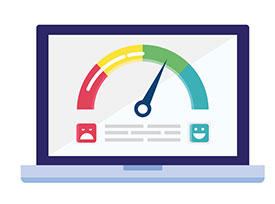 Most likely it will last even longer, because almost no one in the field will use a computer continuously for many hours without it ever idling or going to sleep.
Most likely it will last even longer, because almost no one in the field will use a computer continuously for many hours without it ever idling or going to sleep.
- Minutes per watt-hour -- that's the closest in electronics to "miles per gallon" in a vehicle. The gas tank holds that and that many gallons, and the vehicle gets so and so many miles for each gallon. The computer's battery holds that and that many watt-hours of electricity, and the computer runs so and so many minutes for each watt-hour. That's good to know.
- Watt-hours per hour -- this is the electricity equivalent of the "liters per 100 kilometers" many European nations use instead of miles-per-gallon. Only, with electricity it shows how many of those watt-hours in the battery is the computer using up every hour of operation.
Below is a screenshot of the final PCMark 10 Battery test result. The benchmark also generates a detailed log file as well as performance data.
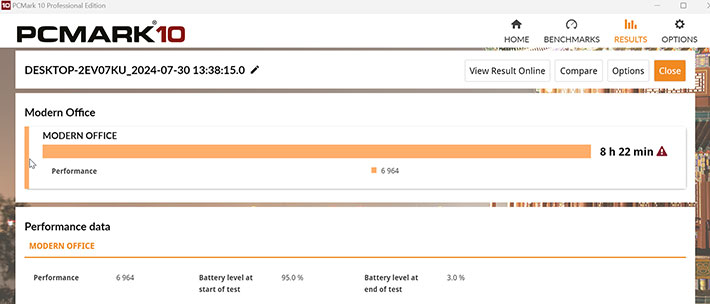
Why this should happen
Is such standardized reporting on energy consumption going to happen in the mobile computer industry? 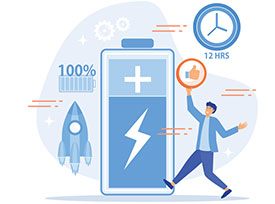 It really should in some shape or form. Knowing how efficient your computer is in doing its work should matter. As is, few people know how much running and charging their computers cost in terms of electricity.
It really should in some shape or form. Knowing how efficient your computer is in doing its work should matter. As is, few people know how much running and charging their computers cost in terms of electricity.
But electricity is part of the cost of running computers. It's like paying for gas for cars or paying for utilities at a home or business. An inefficient computer doesn't hurt as much as filling up a gas guzzler at the gas station does. But if you run a company and have hundreds or thousands of computers, it adds up. The savings of using efficient computers could be substantial.
And how efficiently your computer runs matters in other ways as well. Who wants a gas guzzler computer? Who doesn't hate battery "range anxiety" when work needs to be done and battery power quickly drains away? Who is not at least a little interested in knowing how long a computer really runs on that battery, and how much electricity it consumes?
Real life data and results
To see how much power a variety of mobile computers from different manufacturers use, examine the data in the table below. It's from our RuggedPCReview.com testing lab, and shows how long rugged laptops and rugged tablets we tested lasted on a charge of their battery or batteries.
The Hours column shows the precise time each system lasted running the PCMark 10 Modern Office battery draw down test before it was out of charge.
We highlighted the Watt-Hours per Hour and Minutes per Watt-Hour columns in green because they show, in two different ways, the absolute power use of each system. These numbers are each system's actual "gas mileage." The Battery Watt-Hour column shows the storage capacity of the battery or batteries used in the test.
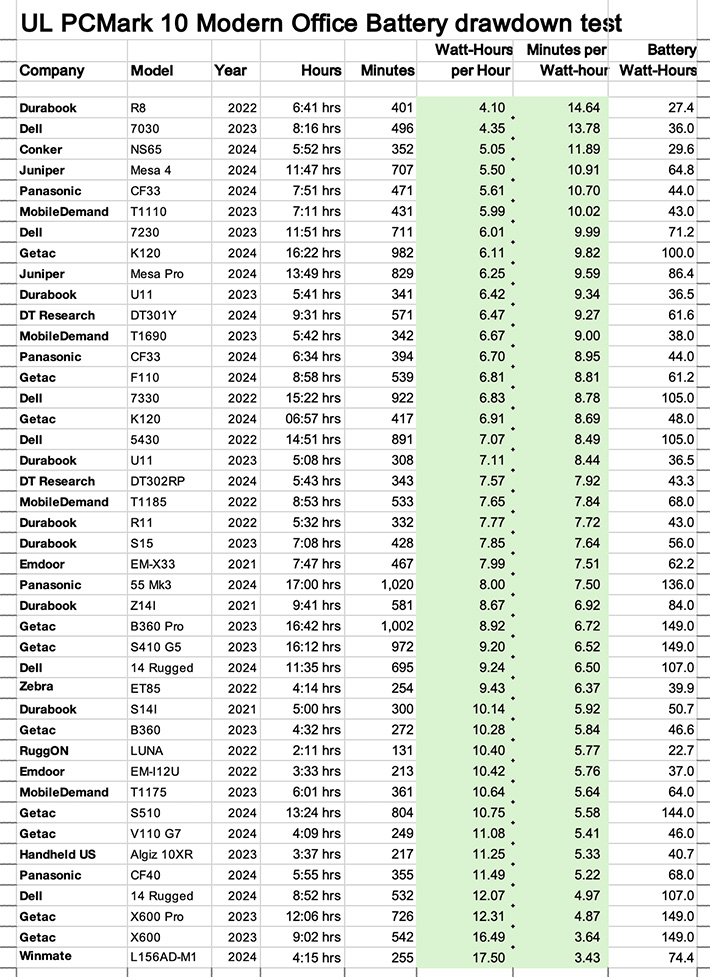
Copyright 2025 RuggedPCReview.com

















 Since battery life definitely matters, why can't it be tested and listed more like gas mileage on a car or truck, so you know how many miles per gallon you can expect (or liters per 100 km in other parts of the world)? Those measures, mandated by the government, may not be perfect, but they do provide an idea of how efficient a vehicle is, and how often you have to fill up. If you know how much fuel goes into your tank and how many miles per gallon your vehicle gets, that gives you a pretty good idea how far you can go and whether that's good enough for your driving habits and patterns.
Since battery life definitely matters, why can't it be tested and listed more like gas mileage on a car or truck, so you know how many miles per gallon you can expect (or liters per 100 km in other parts of the world)? Those measures, mandated by the government, may not be perfect, but they do provide an idea of how efficient a vehicle is, and how often you have to fill up. If you know how much fuel goes into your tank and how many miles per gallon your vehicle gets, that gives you a pretty good idea how far you can go and whether that's good enough for your driving habits and patterns.
 A Double-A battery may be listed as 1.5 Volts and 2800 mAH. Watt = Volt x Amps, so that'd be 1.5V x 2.8Amps = 4.2 watt-hours, or 12.6 watt-hours for all three batteries. So that flashlight would burn for about three hours until the batteries are spent.
A Double-A battery may be listed as 1.5 Volts and 2800 mAH. Watt = Volt x Amps, so that'd be 1.5V x 2.8Amps = 4.2 watt-hours, or 12.6 watt-hours for all three batteries. So that flashlight would burn for about three hours until the batteries are spent.
 There could be a carefully designed set of tasks that the system would run, and the test would then measure how much energy is consumed to complete the test. The results would then give users an idea of how much battery "life" they can expect.
There could be a carefully designed set of tasks that the system would run, and the test would then measure how much energy is consumed to complete the test. The results would then give users an idea of how much battery "life" they can expect.
 A very bright backlight draws a lot of power, so brightness should be set to a reasonable level, say 200 nits -- perfect for indoor use -- for testing.
A very bright backlight draws a lot of power, so brightness should be set to a reasonable level, say 200 nits -- perfect for indoor use -- for testing.
 Most likely it will last even longer, because almost no one in the field will use a computer continuously for many hours without it ever idling or going to sleep.
Most likely it will last even longer, because almost no one in the field will use a computer continuously for many hours without it ever idling or going to sleep.

 It really should in some shape or form. Knowing how efficient your computer is in doing its work should matter. As is, few people know how much running and charging their computers cost in terms of electricity.
It really should in some shape or form. Knowing how efficient your computer is in doing its work should matter. As is, few people know how much running and charging their computers cost in terms of electricity.
